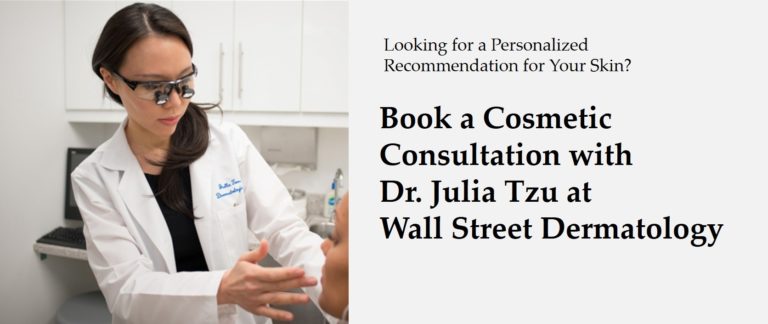Achieve Clearer Skin with
Mole Removal in NYC
Dermatologist specializing in safe & effective cosmetic mole removal in NYC
- Last Updated: March 29, 2024
- By Julia Tzu, MD FAAD
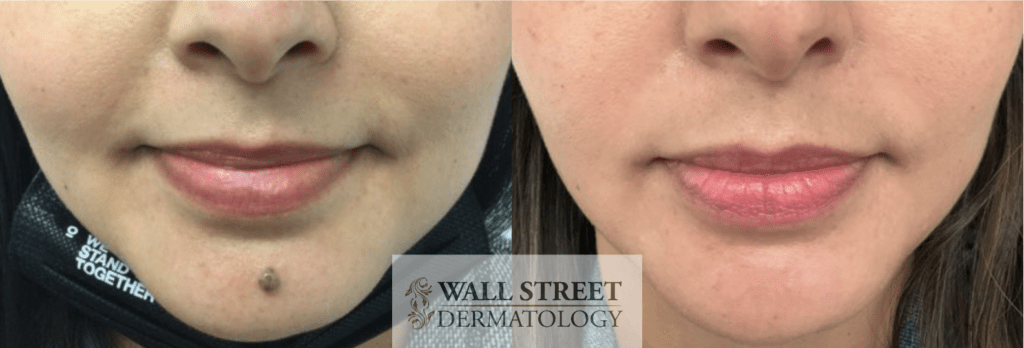
Discovering an unwanted mole can be unsettling, affecting your appearance and well-being. Dr. Julia Tzu and the esteemed team at Wall Street Dermatology offer a compassionate and expert approach to mole removal in NYC, combining advanced techniques with personalized results.
Under the skilled hands of Dr. Julia Tzu, Wall Street Dermatology stands out for its commitment to excellence in dermatological care. We offer a range of effective mole removal options tailored to meet your unique needs, including nonsurgical and surgical removal.
Book an appointment at Wall Street Dermatology today for effective and personalized mole removal in NYC.
Dermatologist Dr. Julia Tzu on Cosmetic Mole Removal
“Cosmetic mole removal is one of my favorite procedures because of how satisfying its outcome can be to patients who have waited too long to remove an unsightly mole. Mole removal can be performed via a variety of modalities, and I always seek to find the least invasive option to provide the best cosmetic outcome. However, even when the only option is surgery, mole removal can still result in imperceptible scarring because of special surgical techniques and equipment I utilize.”- Dr. Julia Tzu, MD, FAAD
Why Choose Dr. Julia Tzu for Mole Removal?
- One of the most experienced mole removal surgeons in NYC with 10,000+ mole removal performed
- Glowing reviews on Google & Yelp
- Top-of-the-line cosmetic outcomes (see Before & After)
- Full range of mole removal procedures performed (laser, shave, surgical excision)
- Academic credentials: Stanford undergrad, MD from Johns Hopkins, University of Miami dermatology residency, clinical fellowships from NYU & University of Pennsylvania (skin surgery & cosmetic dermatology)
- Clinical Assistant Professor at NYU School of Medicine since 2012
- Castle Connolly “Top Doctor” since 2015
- Cosmetic Advisory Board at IT Cosmetics (L’Oreal)
- Easy online scheduling. Book anytime.
If you need help with scheduling or have any questions, call (212) 931-0538.
What Causes Moles?
Benign moles appear due to a variety of factors, with the most common being a combination of environment and genetics. Those with a family history of moles are more likely to develop them, and factors like age and sun exposure can contribute to their formation.
While most moles are of no medical concern, new or existing moles that change color or shape may warrant immediate evaluation. At Wall Street Dermatology, we’ll help you determine if mole removal is in your best interest.
Mole Removal Before and After
How Much Does Mole Removal Cost in NYC?
At Wall Street Dermatology, the mole removal cost in NYC is typically $850 to $3000 per treatment session of each mole removed. Out of pocket mole removal costs depends on the size and location of the mole, and the complexity of the technique utilized for removal. Because the procedure is considered cosmetic and elective, mole removal is not covered by health insurance.
Multiple sessions may occasionally be required to get to the optimal cosmetic outcome on the mole removed. To get a more accurate estimate of your mole removal cost, schedule a consultation with Wall Street Dermatology today.
Types of Moles
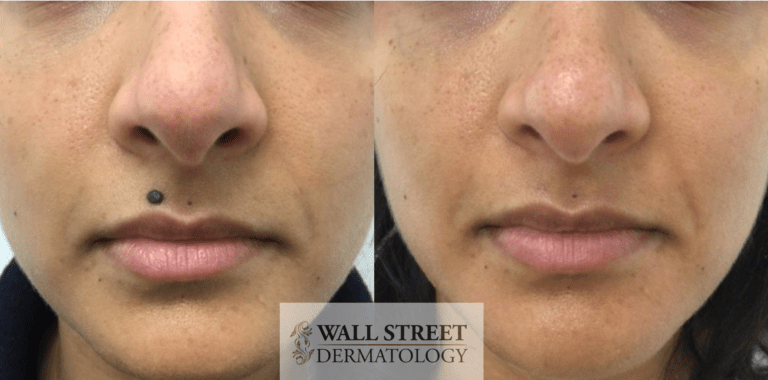
Moles, also known as nevi (nevus, singular) can come in many forms, with classification based on when moles develop in life and how they appear clinically and under the microscope. Whether for medical or cosmetic reasons, Wall Street Dermatology treats many different types of moles, so you can get the help you need no matter what.
Below are some of the most common types of moles we treat with mole removal in NYC.
Atypical or Dysplastic Nevus
Atypical moles, also referred to as dysplastic moles, are defined by their unusual features when viewed under a microscope. Clinically, they can have irregular borders, inconsistent pigmentation, asymmetrical, or appear bumpy or raised in an irregular way. Atypical moles are common and considered benign, but individuals with them should take care as they can be a marker for increased risk of melanoma.
If a person has more than 50 of these moles, they may be at higher risk for skin cancer, and a biopsy can be performed to assess whether an irregular appearing mole is actually atypical or dysplastic. Some biopsy proven atypical or dysplastic nevi may need to be completely surgically removed as they are considered “precancerous”.
Spitz Nevus
Spitz nevus moles are a rare kind of non-cancerous growth that can occur anywhere on the body. These moles are defined by their domed shape and reddish-brown pigmentation, and have been known to grow quickly and then not grow at all for a long period of time. While Spitz nevus moles are considered benign, many dermatologists feel that they should be surgically removed due to its unusual appearance under the microscope, and thereby avoid potential confusion with melanoma.
Acquired Nevus
While some of the moles that a person will have appear at birth, acquired moles are ones that have formed after birth. This is a common occurrence, so common that acquired moles are also referred to as “common moles,” and in most cases, they are no cause for concern. These moles have benign features including a round shape, symmetry, smooth borders, homogenous color, and small overall size.
While not medically concerning, these moles are often removed for cosmetic reasons.
Congenital Nevus
Congenital moles, often commonly referred to as “birthmarks”, are moles that form within the first year of a baby’s birth. Congenital moles only occur in 1-2% of the population. They can be found on any part of the body, and although benign, they should be monitored for potential signs of melanoma.
Congenital nevi may sometimes be perceived as unsightly and removed for cosmetic reasons.
Difference Between Mole vs. Cyst vs. Skin Tag
Identifying different skin lesions can be difficult for the untrained eye. Moles, cysts, and skin tags are some of the most common lesions people notice on their skin, and although they may share many similarities, they have a handful of distinct differences.
Beginning with moles, these skin lesions come in many different sizes and variations of skin colored to brown. They can be raised from the skin or flat, and appear almost anywhere on the body. Moles are usually harmless, but they can be removed for aesthetic reasons, or if the mole is in an area that experiences frequent friction.
Whereas moles grow above the skin, cysts grow under it. Cysts can be unsightly and sometimes painful, but they are usually non cancerous. They often contain fluids or other solid substances that can be drained to reduce the size of or surgically excised to eliminate the cyst.
Skin tags can often be mistaken for a mole, but the key difference is they are fleshy growths that “dangle” from the skin by a thin stalk. They can vary in length and width and often appear in areas of high friction, like under the arms. Hormonal changes can also affect the formation of skin tags, but they are usually harmless when they do form.
Mole Removal Aftercare & Recovery
Recovery for most mole removals is simple and brief, and patients often return to their daily routine immediately following a procedure. For laser and shave mole removal procedures, mole removal aftercare involves applying vaseline and a bandage for 7 to 14 days, after which point the treatment site should be mostly healed. Mole removal excision requires sutures following the procedure, and in the 2 weeks after surgery, exercise should be avoided to prevent reopening the wound.
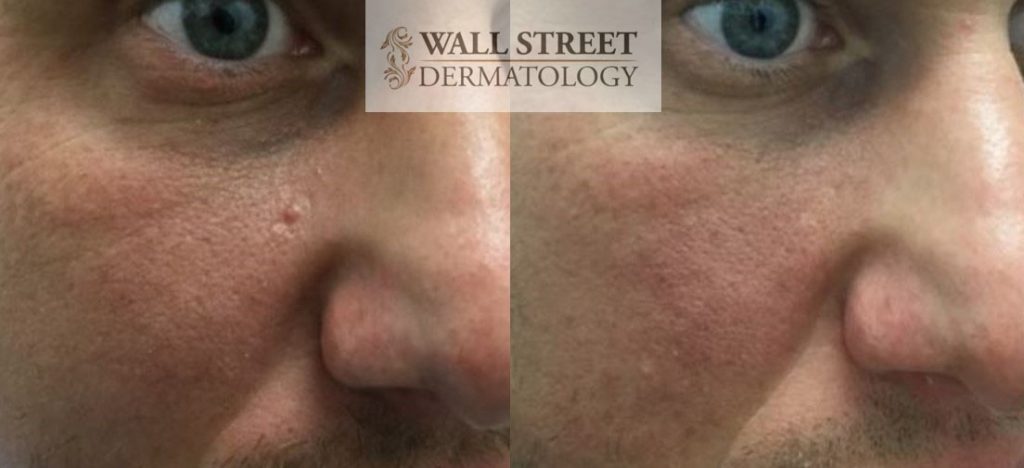
Mole Removal Results
The results of mole removal can vary depending on the procedure that was performed, but most patients should notice the disappearance of their mole immediately following their procedure.
Following a shave mole removal, patients should notice that their mole has completely disappeared, flattened, or significantly reduced in size. This method of removal can be effective for superficial moles, but for moles that travel deeper under the skin, they may reappear over time.
Surgical mole removal is meant to be a permanent solution for larger and deeper moles, as the goal is to remove them at the base. So long as all of the mole tissue has been removed and there is a border of normal tissue around the excision site, the mole should not recur.
Laser mole removal can be an effective way to completely remove superficially located moles, although incomplete removal and recurrence is still possible. Once the treatment area has healed, patients should notice the mole and resulting pigmentation has lightened.
Top Considerations in Cosmetic Mole Removal
Don’t wait to address unwanted moles! Many patients avoid mole removal due to fears of scarring or misconceptions about home remedies. Dr. Julia Tzu encourages consulting a dermatologist for safe and effective mole removal with minimal scarring.
Top considerations when considering a mole removal include:
- Know your mole:
- Appearance: Consider size, shape, color, and location. New or rapidly changing moles need professional evaluation.
- Type: Differentiate between moles (“nevi”) and skin tags, sun spots, or seborrheic keratoses, which require different removal methods.
- Prioritize safety:
- Avoid self-treatment: Improper removal can worsen cancerous growths. Seek a dermatologist’s diagnosis and removal method.
- Skip salon removal: It’s medically risky and may not ensure complete removal.
- Understand the process:
- Multiple moles: Some are removable in one session, while others require individual, skilled surgical removal.
- Location matters: Facial moles, especially on eyelids, nose, lips, and ears, demand specialized techniques for optimal cosmetic outcomes.
- Address your concerns:
- Confidence: Don’t let anxieties about scars or surgery prevent mole removal.
- Open communication: Discuss your concerns with a dermatologist experienced in mole removal.
Types of Mole Removal Procedures

Surgical Shave Mole Removal
Shave mole removal is a minimally invasive surgical technique in which the mole is surgically sculpted down to blend in seamlessly with the surrounding skin. It can be used to remove small, superficial moles (junctional nevus) or small, fleshy protuberant moles (intradermal nevus). While this is a simpler and faster procedure compared to traditional mole removal surgery, there is a higher chance that the mole can recur if the mole has a deeper component (“roots”) . The procedure is performed under local anesthesia and takes approximately 5 minutes. Follow-up care involves only vaseline and a bandage for 7 to 14 days. Sutures are not used with this method, so you may return to your normal daily activities sooner than traditional surgical mole removal.
Surgical Mole Removal Excision
Traditional surgical excision of a mole is reserved for larger and deeper moles called compound and intradermal nevi. Compared with shave removal, mole removal surgery is a lengthier and technically more complex procedure. The skin around the mole is first numbed with an injection of local anesthesia. The mole is then surgically excised all the way down to the subcutaneous layer to ensure its complete removal. The excisonal wound is then carefully closed with sutures, which are removed in 1-2 weeks. The method of closure, also called skin reconstruction, may range from simple to complex depending on the location of the mole removal surgery. The entire procedure usually takes about 30 minutes. Follow-up care involves only vaseline and a bandage for 7 to 14 days. You can go home immediately after your mole removal surgery but are advised to avoid exercise for 2 weeks to prevent reopening the wound.
Laser Mole Removal
During laser mole removal, your dermatologist uses precision-targeted bursts of light to break down the mole. This technique effectively removes the mole without harming the surrounding skin. It’s most often used to remove superficial, non-cancerous moles in sensitive or visible areas like the ears, neck, or face.
Depending on the size and the depth of the mole, it may take several sessions for moles to be completely removed with laser treatment. The procedure takes just a few minutes and requires no downtime. Patients may be instructed to apply petroleum jelly or another ointment to the area for several days following the procedure.
It’s important to note that laser mole removal is contraindicated for moles that are irregular or which may be cancerous. Before beginning this treatment, the moles you’d like to remove should be deemed completely benign by an experienced board-certified dermatologist.
Mole Shaving vs. Excision
Moles are most commonly removed via a superficial removal called a “shave removal” or a deeper surgical removal that involves sutures. While shave removals are a quicker and less costly procedure, it can leave the base of the mole remaining. This means that when the shave wound heals, the brown discoloration can recur at the base and the mole can eventually reform again. True surgical removal requires more sophisticated techniques, are more time consuming to perform, and are more costly, but remove the mole completely so that probability of recurrence is reduced.
Which cosmetic mole removal procedure is best depends on an assessment of the depth of the mole, patient’s personal goals, and the location of the mole. There are certainly instances in which a shave removal provides the best outcome and there are instances when a surgical removal provides the best outcome. During your mole removal consultation, Dr. Tzu will listen to your specific concerns and formulate with you the best treatment strategy depending on your individual goals and other limiting factors.
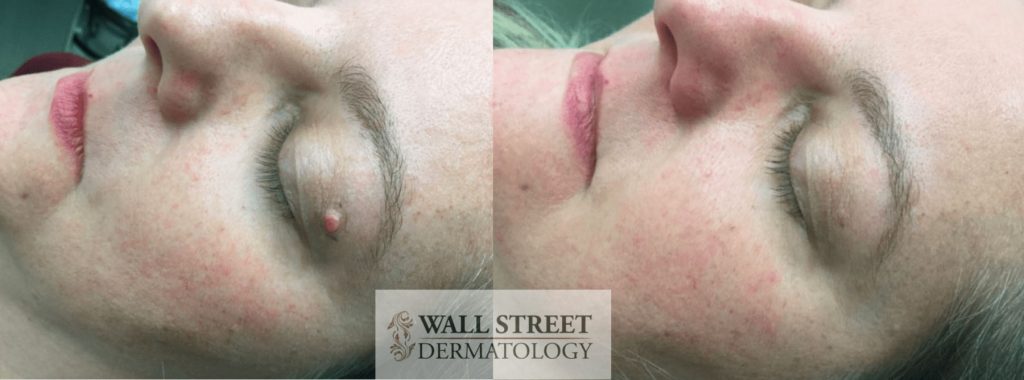
Dermatologic Surgeon vs. Plastic Surgeon for Mole Removal
Mole removals are generally done by specialized cosmetic dermatologists or plastic surgeons. Dermatologic surgeons are specialists whose sole professional focus is medically diagnosing skin growths, tailoring the type of skin surgery to the type of skin growth, and optimizing scarring outcomes on the skin. There is no other medical specialist more experienced and focused on understanding the biology of skin growths and its removal as well as improving scarring outcomes of the skin than dermatologic surgeons. While plastic surgeons are experts in cosmetic enhancements overall, cosmetic skin surgery is only a partial subset of the types of cosmetic procedures they routinely perform. Scarring from many of the more invasive surgical cosmetic body procedures is only a secondary consideration. If going to a specialist with the most amount of expertise and experience is important to you, you may want to consider seeing a dermatologic surgeon over a plastic surgeon for skin surgery.
Schedule a Mole Removal Consultation Today
You can schedule a visit with Dr. Julia Tzu, a dermatologist in NYC, and her experience team at Wall Street Dermatology to explore further with us. If you are interested in exploring a cosmetic mole removal procedure in NYC, you can book a cosmetic consultation with Dr. Tzu for a 1:1 session to explore possible mole removal procedures. We’d love to explore how we may be able to restore the natural beauty of your skin.
Mole Removal FAQ
How long is mole removal recovery?
Mole removal recovery is quick and stress-free, with recovery taking no more than two weeks for most procedures. During this time, aftercare includes applying vaseline to the treatment area and keeping any wounds bandaged.
Does mole removal leave a scar?
Mole removal will often leave a scar immediately after the treated area has healed, but it is possible for these scars to improve over time. Mole shave and laser removal will usually create less significant scarring than an excision, and the proper aftercare should keep any scarring from remaining too noticeable.
Is mole removal permanent?
Most mole removal techniques are meant to be permanent solutions to a wide variety of mole types, but there are certainly cases where a mole may come back. Mole shave removal and laser treatments are effective at reducing and sometimes eliminating the appearance of a mole, but deeper moles can come back if the base is not removed. Mole excision is the most reliable method of permanent mole removal, as it is meant to remove everything, including the base.
Can mole removal cause nerve damage?
Mole removal is a minor surgery involving the skin only, so the risk of nerve damage is very low. A professional dermatologic surgeon should be able to minimize nerve damage and ensure that every aspect of the mole removal process goes smoothly.
Who is a good candidate for cosmetic mole removal?
Anyone who is unhappy with the appearance of their mole and seeks cosmetic enhancement should consider cosmetic mole removal. Cosmetic mole removal can be performed on most individuals, as long as there is no severe medical condition that would prevent a minor elective procedure. However, because cosmetic mole removal is considered medically unnecessary, it is not covered by insurance.


